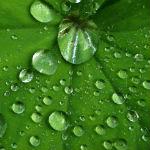 United States. A new class of superhydrophobic nanomaterials could simplify the process of protecting surfaces from water.
United States. A new class of superhydrophobic nanomaterials could simplify the process of protecting surfaces from water.
A material made by scientists from Rice University, Swansea University, the University of Bristol and the University of Nice Sophia Antipolis is inexpensive, non-toxic and can be applied to a variety of surfaces by spraying or spin-coating.
The hydrocarbon-based material may be a "green" replacement for expensive fluorocarbons, dangerous commonly used for superhydrophobic applications, said Andrew Barron, leader of the research.
"Nature knows how to make these materials and that they remain environmentally friendly," Barron said. "Our job has been to figure out how and why, and emulate that."
The lotus leaf was on their minds by researchers trying to mimic one of the planet's most hydrophobic surfaces – water repellent. Barron said the leaf's capabilities spring from its hierarchy of microscopic, nanoscale double structures.
The fabrication and testing of what the researchers call a branched hydrocarbon low-surface energy material (LSEM) was carried out by lead author Shirin Alexander, a research officer at the Energy Security Research Institute on the Campus of Swansea Bay University.
There, Alexander coated the nanoparticles of synthesized aluminum oxide with modified carboxylic acids that feature highly branched hydrocarbon chains. These tip chains are the first line of defense against water, making the surface rough. This roughness, a feature of hydrophobic materials, traps a layer of air and minimizes contact between the surface and water droplets, allowing them to slide outward.
To be superhydrophobic, a material has to have a water contact angle greater than 150 degrees. The contact angle is the angle at which the surface of the water meets the surface of the material. The larger the rim, the greater the angle. An angle of 0 degrees is basically a puddle, while a maximum angle of 180 degrees defines a sphere only by touching the surface.

























Leave your comment